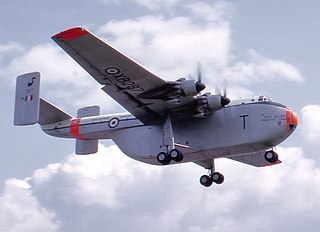Related Research Articles

The Blackburn B-101 Beverley was a heavy transport aircraft produced by the British aircraft manufacturer Blackburn Aircraft. It was notably the only land-based transport airplane built by Blackburn, a company that otherwise specialised in producing naval fighter aircraft.

The RyanNavion is a single-engine, unpressurized, retractable gear, four-seat aircraft originally designed and built by North American Aviation in the 1940s. It was later built by Ryan Aeronautical Company and the Tubular Steel Corporation (TUSCO). The Navion was envisioned as an aircraft that would perfectly match the expected postwar boom in civilian aviation. It was designed along the general lines of, and by the same company which produced the North American P-51 Mustang.

The SAAB 21 is a Swedish single-seat low-wing monoplane fighter and attack aircraft designed and manufactured by SAAB. It used a relatively unorthodox twin boom fuselage with a pusher engine, giving the aircraft an unusual appearance.

The Miles M.57 Aerovan was a British twin-engined short-range low-cost transport aircraft designed and produced by Miles Aircraft. It was primarily used for freight and passenger services.
General Aircraft Limited was a British aircraft manufacturer from its formation in 1931 to amalgamation with Blackburn Aircraft in 1949 to become Blackburn and General. Its main products were military gliders and light transport aircraft.

The General Aircraft GAL.42 Cygnet II was a 1930s British single-engined training or touring aircraft built by General Aircraft Limited at London Air Park, Hanworth.

The General Aircraft GAL.45 Owlet was a 1940s British single-engined trainer aircraft built by General Aircraft Limited at London Air Park, Hanworth.

The Miles M.28 Mercury was a British aircraft designed to meet the need for a training and communications plane during the Second World War. It was a single-engined monoplane of wooden construction with a twin tail and a tailwheel undercarriage with retractable main units.
The Arpin A-1 was a two-seat low-wing monoplane which was powered by a single radial engine in pusher configuration, mounted behind the cabin between twin booms that carried the tail. An unconventional fixed tricycle undercarriage was fitted. Only one was built.
The Avro 558 was a British single-engined ultralight biplane built by Avro at Hamble Aerodrome.

The General Aircraft Monospar ST-25 was a British 1930s light twin-engined utility aircraft.
The Piper PA-6 Sky Sedan was a 1940s American four-seat light aircraft designed and built in prototype form by Piper Aircraft at its Lock Haven, Pennsylvania, factory.

The General Aircraft Monospar was a 1930s British family of touring and utility aircraft built by General Aircraft Ltd (GAL).

The Heston JC.6 was a British prototype air observation post aircraft designed and built by the Heston Aircraft Company Limited, who had previously built the Heston Phoenix, the Heston T.1/37 and the Napier-Heston Racer. The JC.6 was also known as the Heston A.2/45 or the Heston AOP.

The British Aircraft B.A.IV Double Eagle was a British twin-engined six-seater monoplane designed and built by the British Aircraft Manufacturing Company of London Air Park, Hanworth, England.
The Fane F.1/40 was a 1940s British air observation post aircraft design by Captain Gerald Fane's Fane Aircraft Company.

London Air Park, also known as Hanworth Air Park, was a grass airfield in the grounds of Hanworth Park House, operational 1917–1919 and 1929–1947. It was on the southeastern edge of Feltham, now part of the London Borough of Hounslow. In the 1930s, it was best known as a centre for private flying, society events, visits by the Graf Zeppelin airship, and for aircraft manufacture by the Whitehead Aircraft Company during World War I and General Aircraft Limited (GAL) 1934–1949; in total over 1,650 aircraft were built here.
The Beagle B.218X was a 1960s British four-seat twin-engined light transport monoplane built by Beagle Aircraft Limited at Shoreham Airport. The prototype was modified into the Beagle B.242X but neither variant entered production.
The Latécoère 225 was an unusual single seat canard microlight amphibian, with a swept wing, and of pusher configuration. It first flew in 1984 but was not put into production.
The Akaflieg Stuttgart fs28, nicknamed Avispa is a single engine, twin boom pusher configuration light sports and utility aircraft designed at the University of Stuttgart in West Germany in the 1970s. Unusually, it has an inverted V-tail. The sole example remained active as of 2010.
References
- The Illustrated Encyclopedia of Aircraft (Part Work 1982–1985). Orbis Publishing.
- Jackson, A.J. (1974). British Civil Aircraft since 1919. London: Putnam. ISBN 0-370-10014-X.